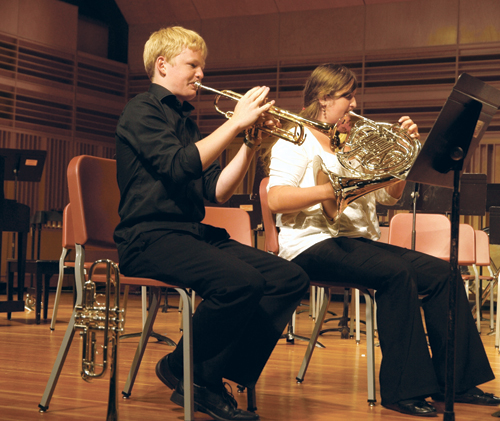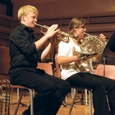
Most of the practical tips I have learned over my 35 years of teaching have come from colleagues, clinics, and good old common sense. There is no magic bullet that will cure all of the challenges we face as band directors.
One of the best things I ever did was to start a journal of the practical ideas that really worked to improve my program. Many teachers attend clinics and conferences and come home inspired and ready to take on the world. My suggestion is to type out those ideas that really speak to you while they are still fresh in your mind. Try to place these ideas into categories – e.g., Pitch, Tone, Phrasing, Articulation, etc. The key is to keep a list on your computer of techniques that work for you. Below are a few ideas that have worked for me.
Warming Up the Band
Set the mental stage for rehearsal by informing students clearly about your expectations and their responsibilities. Put your plan on the board every day. This also gives the percussion time to get the correct instruments ready.
Every student must have a pencil. Do a pencil check. Grade students on this. Also remind them: “A short pencil is better than a long memory.”
For warmups, try having the brass buzz on the mouthpiece while the woodwinds play.
Stress the importance of good tone quality from the first day of band. Insist on a resonant and centered sound. Remind students that developing a tone quality is probably the most important thing they can do to improve the sound of the ensemble.
The purpose of a warmup is to prepare students mentally and physically. It serves to bring the instruments to room temperature and to get embouchures loosened up before tuning. The reason that we warm up on long tones, chords, chorales, and the like is so that the students can concentrate on quality of sound and pitch center in relationship to the overall band.
Pitch and Intonation
Good pitch is a direct result of good tone quality. Remind students to begin every day with their instrument’s tuning set where it was the previous rehearsal and to keep the instrument warm during rehearsals and concerts.
Students need to know what to listen for as they tune. Tune the tuba. All first chair players should listen to the tuba. Then the second chair should tune to the first chair, the third chair to the second, and so on. The sound your students play should melt into whomever they are listening to. Work to eliminate any beats in the sound.
Tune up in the same key and volume as your first piece. Practice long tones both soft and loud, with a tuner.
Sing more in rehearsals. Singing is a great tool: use it!
All students should learn how to read up and down an octave. You may want to have the flutes or clarinets play certain passages down an octave if the overall sound is too strident.
Have the band play a concert F scale. As they do this, try to make the top note sound as dark and in tune as the bottom note.
Try to have your students bend notes up and down using just the embouchure. Explain that all instruments have different pitch tendencies, and a performer must always listen and adjust.
Have the entire band play a unison pitch after tuning. Point to one person and have everyone else stop. Decide as a band if the note is sharp or flat.
Adjusting pitch is like riding a bike, because the players must make little automatic adjustments in order to stay upright, or in tune.
Establish with your students a basic awareness of the tendencies of certain chord voices. For example, a perfect fifth needs to be two cents higher; a major third needs to be 14 cents lower; a minor third needs to be 16 cents higher, etc. Discuss the concepts of equal temperament versus just intonation.
Sing any pitch. Have students find it by ear only. Move your hands (or point) to make the students bend the pitch up and down. When you bring your hands together, the students should sing a perfect unison. Do this when playing with the instruments as well.
Tune major, minor, and diminished chords using this method. First, explain and then play a major triad. Then, using hand signals, lower the third (to make it minor), lower the fifth (to make it diminished), lower the root (to produce a major triad a half step down). Continue the sequence from there.
Remind students that even professional symphony orchestras play out of tune. The orchestra sounds in tune only because the players adjust each note so quickly that the intonation problem never reaches the ear of the listener.
After tuning a chord in the music, have your students mark an arrow (up or down) above the note to remind them which way to bend the pitch. The height of the arrow can indicate how much to bend the note.
Tone and Balance
Here are some concepts to keep in mind with regard to tone and balance:
The formula for good tone: Embouchure plus air equals tone.
Any melodic line should be one-third top and two-thirds bottom.
Correct balance takes care of many intonation problems. On marches and faster pieces, take time to isolate chords and play them with fermatas in order to isolate pitch problems.
Have two students (first on the same instruments, then different instruments) sit next to each other and play a unison note. As they do this, have the rest of the band close their eyes and see if they can hear when the two instruments sound like one homogeneous new instrument.
Memorize a simple chorale as a band. As they play it, the students can then devote their entire attention to listening and watching, since they no longer have to read the music.
Students should strive to put their sound inside a lower and darker sounding instrument. For example, a trumpet should try to put its sound inside a French horn, a French horn sound inside tuba, a clarinet sound inside bass clarinet, and so forth.
Players should always listen down and try to put their sound inside another instrument. Higher sounding instruments should realize that their sound is one of the harmonics of the lower sounding horns.
Read Francis McBeth’s book again. The pyramid of sound is a good tool.
Articulation
Use the concept of stage make-up as you try to get articulations across. The audience must hear it. The same idea applies to dynamics.
Articulations depend on the style and era of the piece: Mozart and Stravinsky accents are very different.
Practice various articulations in scales during warmups. In general, students need to practice more legato.
Lift and separate notes in marches and similar pieces. Use buoyant air support.
Experiment how to release a fermata. I suggest having the upper instruments release first and the lowest instruments release last. Try it both ways to prove this theory.
Phrasing
Every musical line should have direction.
Most bands do not play with enough passion. Music is boring without feeling. There should be more shape to musical lines and more extremes in the dynamics. Sing a line then play it. Play like you talk, with inflection in your sentence, which will help to develop a musical line.
Playing dissonances stronger provides for increased satisfaction at resolution.
Music is generally either a song or a dance. Song music is lyrical in nature. Think about the line, and the energy is in the center of the note. This often provides for more nuance in tempo. Dance music, by contrast, is rhythmic in nature. Think about the rhythm, with the energy at the start of the note, and try to use a strict tempo.
Rhythm
Think of double dotting when playing dotted eighth-sixteenth passages. Play it as a triplet, and then play it correctly to show the difference.
Subdivide all fast groupings of notes and then speed them up. If you continue to practice a passage incorrectly at a fast tempo, you are simply getting good at being bad.
Try practicing tempo changes first without the conductor to see where the natural speed is, and then practice the same passages with the conductor.
Have students play everything with just the attack; do not hold out pitches. This pointillist approach is a good way to practice pieces with many different entrances. Then, after practicing this way, play it as written.
Breathing/Posture
Two of my favorite quotes about air and breathing are “Air is free, use it,” and “Air is your friend.”
To work on posture, have a contest among your students to see who can stand up the quickest. Ready position is the correct posture.
Students should be told not to think about embouchure when they are playing. Instead, they should think only about air.
Get percussion players to breathe with the wind players, which will help them to start phrases together.
Practice hissing like a snake. Hiss a phrase, and then play it.
Practice playing longer phrases. Have a contest to see who can play the longest (just to demonstrate that students can play longer than they think they can).
Project the air all the way through the instrument. Imagine making the bell vibrate. Students should think of the air going out of the bell, not just into the mouthpiece.
Remind your students about proper instrument playing position often.
Students should think of playing a wind horn. In other words, they should use fingerings and blow, rather than just buzzing.
Performance Protocol
Explain to students exactly what is expected for concert dress (send home a hand-out on this).
Rehearse tuning procedure for performance as well as when to stand and sit. Remind students that there must be absolutely no talking on stage during a concert.
Percussionists should know exactly where to be at all times. Often these players are the only ones moving on stage, and so this may be where the audience members focus their attention. Keep any movement to a minimum.
If you must tune on stage, make it simple and quick. Do not tune individuals on stage. Consider playing an easy chorale to warm the instruments and to get a sense of pitch.
Conducting
In rehearsals conducting should be like a good conversation. Listen more, talk less.
The attitude of the conductor toward rehearsal techniques and the music being rehearsed will directly reflect how the students view these things. Be positive and passionate.
Videotape yourself conducting during band rehearsal. You may be surprised at what you see.
Students care far more about how you feel about the music than how much you know.
Do more score study. Mark up the score more than you normally would. Listen to recordings, but do your own interpretation. Pick the pieces you believe in, not just what others say is good. Picking the correct literature for your band is one of the most important things that will help your program.
Talk to other directors about the challenges you may be having. We are all in this together. Many suggestions and answers are just a phone call away. Encourage a colleague that you respect to observe one of your rehearsals. Take that person out to lunch and discuss any ideas for improvement.
Miscellaneous
Rehearse exercises in the circle of fifths (or fourths).
Work on teaching students to play their own part while listening to another part.
Rotate parts. Have your first chair player move down to the third part on occasion. Be creative and let all students feel important.
Write the word focus on the board, and remind students repeatedly that all of the ideas you have discussed will mean nothing if there is no focus. Relate this point about focus to real life situations, such as the Olympics or listening to instructions for the SAT test.
Sitting too close together will prevent the lows from projecting, and it also may cause some higher overtones to come out too much. Put some space between the musicians. Have them fill up an imaginary circle with their sound.
Sectionals are extremely important. Talk to student leaders and have them help with the organization and rehearsal of sectionals. This is a win-win situation.
Remind students to keep their instruments clean. Every now and then have your students take out their mouthpieces and look through them into the light. This is important for both good health and a good sound.
Encourage students to form duets and small ensembles. This will quickly improve intonation problems, and students will have fun.
Record your rehearsals. You will hear many things that you did not realize were happening. This is also a great way to get ready for your next concert. Listen, then take the time to mark up your score.
Thoughts in Conclusion
All of the ideas above are drawn from years of picking the brains of my friends and colleagues, as well as what I have learned from attending clinics and rehearsals. The key is to use this information in your rehearsals. Try one or two concepts that you think will help your group. Common sense should be your guide.






